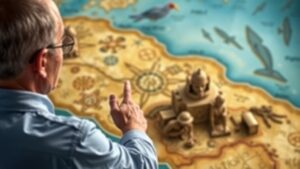Understanding Disguised Coordinates Embedded in Religious Maps
Understanding Disguised Coordinates Embedded in Religious Maps
The intersection of geography and spirituality is often illustrated through religious maps. These maps serve not merely as geographical guides but also as tools for conveying cultural narratives, symbolizing power, heritage, and belief systems. But, an intriguing aspect of religious maps is their use of disguised coordinates–deliberate alterations or hidden meanings embedded within them. This article explores how these coordinates manifest themselves, their implications, and their significance in religion and culture.
Defining Disguised Coordinates in Religious Contexts
Disguised coordinates in religious maps refer to specific locations or routes that are altered, obscured, or symbolically represented to convey deeper meanings or contextual narratives. These coordinates go beyond mere geographic data; they often encompass historical, spiritual, and cultural elements that serve to enrich the viewers understanding of a particular faith.
An example can be drawn from Christian pilgrimage maps, where certain locations may be marked using symbols or historical references rather than precise geographical indications. This transformation aims to engage the pilgrim’s spirituality rather than just providing a functional navigational tool.
Historical Perspectives on Religious Maps
The evolution of religious maps reveals how societies have historically embedded disguised coordinates to reflect their beliefs. During the Middle Ages, for instance, Christian maps displayed the world according to a theological view, where Jerusalem often occupied the center, symbolizing its paramount importance in the Christian faith.
In Islamic tradition, maps showing the Qibla–the direction Muslims face during prayers–are often designed to emphasize not only geographic orientation but also spiritual focus. The representation of Qibla in maps may utilize abstract art or unique geometric patterns that disguise exact coordinates while inviting reflection on the sanctity of prayer.
Case Studies: Disguised Coordinates in Practice
- The Garden of Eden in Biblical Cartography: Ancient maps often placed the Garden of Eden at locations varying from the Persian Gulf to the vicinity of modern-day Iraq. These disguised coordinates served to convey theological implications about humanity’s origin, as different cultures attached profound meanings to each representation.
- Mount Sinai in Judeo-Christian Tradition: The disputed locations of Mount Sinai illustrate how disguised coordinates can evoke debate and pilgrimage. While many suggest Jebel Musa in Egypt, others argue for locations in Saudi Arabia. Each representation signifies different historical and spiritual narratives, illustrating how geography can influence belief systems.
The Role of Symbols and Iconography
The use of symbols and iconography is a hallmark of disguised coordinates in religious maps. Icons often serve as shorthand for complex ideas. For example, a cross on a map might not just indicate a place where a significant event occurred but also encompass the historical significance and narratives of suffering, redemption, and faith.
Similarly, Hindu maps often depict sacred rivers or sites using colors or shapes that denote their spiritual importance, rather than exact geographic chords. For example, the Ganges River is often illustrated as a broad swath representing not just its physical presence but its transformative power in Hindu lives.
Psychological and Sociological Implications
The psychological underpinnings of disguised coordinates reveal how individuals and groups interpret space through cultural lenses. The notion of sacred geography influences social cohesion and group identity, as locations imbued with religious significance can strengthen communal bonds.
Research suggests that places marked with religious significance can serve as mental anchors for communities, fostering a sense of belonging and continuity. For example, people may have a visceral connection to their religious maps, as these representations shape their collective memory and individual spirituality.
Contemporary Applications of Disguised Coordinates
In today’s global landscape, religious maps continue to evolve with technology. Geographic Information Systems (GIS) and digital mapping have enabled new ways of interpreting disguised coordinates. For example, location-based services in mobile applications may provide users with guided tours of sacred sites that incorporate historical narratives encapsulated within disguised coordinates.
Also, the increasing popularity of virtual reality (VR) experiences simulates religious journeys, allowing users to engage with historic routes and landmarks embellished with cultural stories and symbols. Such innovations marry technological advances with traditional understandings of spirituality and geography.
Actionable Takeaways
- When analyzing religious maps, pay close attention to symbols, icons, and historical context–these are clues to understanding the deeper spiritual narratives at play.
- Consider how disguised coordinates can shape communal identity and influence religious practices within a community.
- Engage with modern technologies, such as GIS and VR, to explore religious maps in new contexts; this enhances understanding of both geographical and spiritual dimensions in contemporary society.
In summary, disguised coordinates embedded in religious maps reflect a rich interplay between geography, spirituality, and cultural identity. Understanding these coordinates enhances our appreciation for the ways in which maps are not merely tools for navigation but are also carriers of profound religious meanings. Such explorations underscore the importance of a holistic approach to studying religious landscapes.



